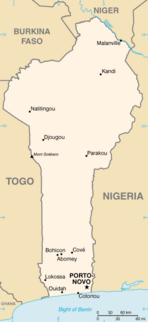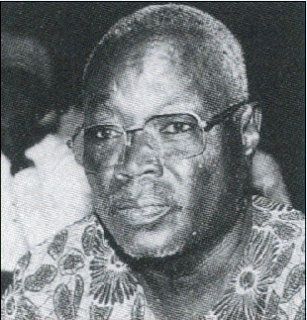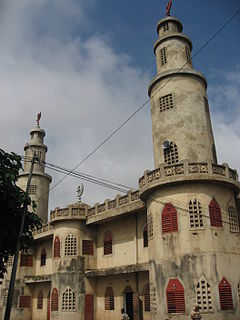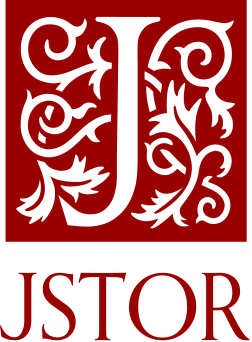
Émile Derlin Zinsou was a Beninese politician and physician who was the President of Dahomey from 17 July 1968 until 10 December 1969, supported by the military regime that took power in 1967. Zinsou was present at the signing of the treaty that formed the African Union on 12 July 2000 in Togo.
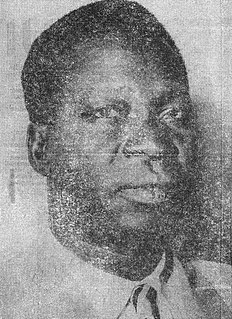
Sourou-Migan Marcellin Joseph Apithy was a Beninese political figure most active when his country was known as Dahomey. He arose on a political scene where one's power was dictated by what region in Dahomey one lived in.

Coutoucou Hubert Maga was a politician from Dahomey. He arose on a political scene where one's power was dictated by what region in Dahomey one lived in. Born a peasant in 1916, Maga served as a schoolmaster from 1936 to 1945, during which time he gradually gained considerable influence among the uneducated. He was elected to Dahomey's territorial assembly in 1947 and founded the Northern Ethnical Group, later renamed the Dahomey Democratic Rally. In 1951, Maga was elected to the French National Assembly, where he served in various positions, including premier from 1959 to 1960. When Dahomey gained its independence from France on August 1, 1960, Maga was appointed to the presidency, and was officially elected to that post on December 11.

Alphonse Amadou Alley was a Beninese army officer and political figure. He was most active when his country was known as Dahomey. He was born in Bassila, central Dahomey, and enrolled in schools in Togo, Cote d'Ivoire, and Senegal before enlisting in the French army in 1950. He saw combat in Indochina from 1950 to 1953, in Morocco from 1955 to 1956, and in Algeria from 1959 to 1961. After the coup in 1965, President Christophe Soglo promoted Alley Chief of Staff of the Army. Young army officer Maurice Kouandété was appointed Alley's chef de cabinet in 1967.

Tahirou Congacou was a Beninese politician, most active during the 1960s, when his country was known as Dahomey. He served as speaker of the National Assembly from 1964 to 1965, and in that capacity served as acting President of Benin from 29 November 1965 to 22 December 1965. He also served as acting foreign minister during 1965.

Colonel Paul-Émile de Souza was a Beninese army officer and political figure. He was chairman of the Directory of Dahomey from December 13, 1969 to May 7, 1970.
Benoît Sinzogan is a Beninese military officer and politician, best known for leading his country's gendarmerie in the late 1960s. He was a member of the Fon ethnic group, which dominated the Beninese army from 1965 to 1967. After Maurice Kouandété usurped the presidency on December 17, Sinzogan was placed under house arrest until December 19. That day, Sinzogan was appointed Minister of Foreign Affairs, his first political post, which he held until July 1968. He was a member of the Military Directorate, which ruled Dahomey from 1969-1970. Academic Samuel Decalo described the man as "too timid to mount a coup" during the 1960s and 1970s, being "one of Dahomey's few senior officers not to attempt to."
The 1963 Dahomeyan coup d'état was staged on October 28, 1963, by Christophe Soglo, who took control of the Republic of Dahomey to prevent a civil war. He overthrew Hubert Maga, whose presidency faced extreme economic stagnation and a host of other problems.
Major Jean-Baptiste Hachème was a Beninese military officer and politician. He was most active when his country was known as Dahomey. Of Fon origins, he entered the national political stage in 1963, when he quelled riots started by supporters of former president Hubert Maga. Henceforth he served under various government positions, including briefly the de facto head of Dahomey.
Paul Darboux was a Beninese merchant and politician, most active when his country was known as Dahomey.
Édouard Dunglas (1891–1952) was a French physician, historian, geographer, and politician who spent a majority of his life in Dahomey.
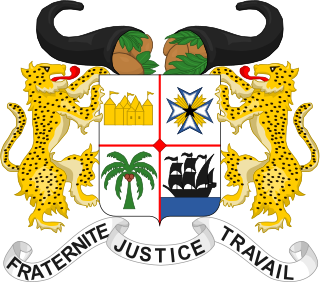
The Dahomeyan Democratic Union was a political party in French Dahomey.

The Dahomeyan Unity Party was a political party in the Republic of Dahomey.

The Dahomeyan Democratic Party was the sole legal political party in Dahomey from 1963 until 1965.
Pascal Chabi Kao is a Beninese politician.
Joseph Adjignon Keke was a Beninese politician.

The 1972 Dahomeyan coup d'état was a military coup staged on 26 October 1972 by Major Mathieu Kérékou, who took control of the Republic of Dahomey and ended a system of government established following the annulled 1970 presidential election, in which three members of the Presidential Council were to rotate in power. Ahomadégbé-Tomêtin served as the Chairman at the time of the coup.



